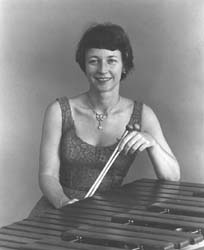Vida Chenoweth
by James A. Strain

Hailed as the "first concert marimbist," Vida Chenoweth, following in the steps of Clair Omar Musser, was one of the most influential artists ever to perform on the instrument. She pioneered compositional, performance and interpretive techniques commonly used on the instrument today, among these the performance of polyphonic music via independent mallets.
Chenoweth, perhaps more than any other artist, is responsible for raising solo marimba to a level of respect equal in stature to violin, piano or guitar. This was done through her high artistic abilities as well as her insistence on performing new works written for the instrument. For many years nearly every major work for the instrument was written for, dedicated to or performed by her.
When told of her election to the Percussive Arts Society Hall of Fame, Chenoweth said that she looked forward to attending the induction ceremony at PASIC '94 in Atlanta. "The news of my being nominated took me by surprise," she said. "It triggered memories of the many years when all my efforts were toward gaining a classical status for the marimba. I am grateful for this honor and anxious to meet with the generation of percussionists who have continued the advancement of the marimba. Some I know now, but it will be a special privilege for me to join the ranks of all the dedicated percussionists in Atlanta."
The performance that catapulted Chenoweth to the forefront as an artist of stature, and also resulted in the critical acceptance of the instrument, was her performance of the Kurka "Concerto for Marimba" with the Orchestra of America in Carnegie Hall. This performance marked not only the premiere of the concerto, which was written for her, but the premiere of the marimba in Carnegie Hall as well.
Now retired from Wheaton College as a professor of ethnomusicology, Dr. Chenoweth received her early musical training from her family, who owned a music store in Enid, Oklahoma. Her older brother, himself a musician, suggested that she be the first classical marimbist to build up her own literature for the instrument. "I was just a child, in junior high school, but I set my sights on achieving that goal."
After attending William Woods College (1947-49), Northwestern University (1949-51), Alliance Francaise, Paris (1950) and the American Conservatory of Music (1953), Chenoweth embarked on a series of tours, performing nearly one thousand recitals throughout the United States and Europe. Ultimately, Chenoweth performed on every continent and appeared as soloist with numerous major orchestras. In addition to her live performances, Chenoweth was the first artist to commercially record marimba music, releasing an album on the Epic label in 1962.
With reviews like "exhilarating" by The New York Times, "a master of her instrument" by The New York Herald Tribune, and "a sensitive musician who raised the level of marimba playing to virtuoso heights" by The Musical Leader, Chenoweth became a driving force behind the creation of new music for the marimba. When asked if she was aware at the time of her pioneering efforts, she says she wasn't. "As a matter of fact, there was an article written by a New York critic called 'Pioneering the Marimba,' and when I read that I thought, 'I didn't know I was pioneering!'"
At the height of her career, an oven explosion threatened her with the loss of fingers on one hand. As her hand miraculously healed, she decided to do whatever she could to better life on earth for all people. Following her Christian beliefs, she chose a career as a linguist, which resulted in several years of study and research in remote areas of the Pacific Islands in order to translate The New Testament into the Usarufa language. From there she pursued a career in ethno-musicology, receiving her Ph.D. in ethnomusicology from the University of Auckland.
In addition to her contributions as a performer, Chenoweth translated David Vela's Information on the Marimba and was the recipient of a State Department grant to study at the University of San Carlos, Guatemala. This grant resulted in her book The Marimbas of Guatemala, long held as the standard reference on the instrument. She is the author of numerous articles and publications in the field of ethnomusicology, and has published edited versions of many works for marimba.
Chenoweth has been associated with the Percussive Arts Society since its inception and is possibly the person who named the organization. "In 1962, during the Tri-State Music Festival in Enid, Oklahoma, Don Canedy called," she remembers. "It was his idea that we talk, saying that we needed some kind of togetherness for all the percussionists and marimbists who were working on their own. As I had just become a member of the Society for Ethnomusicology, I suggested that we should start a 'society' for the percussive arts. I also suggested that we have a summer camp for marimbists, and I said that I would come, but unforeseen circumstances made it impossible. I ended up in Mexico that summer testing a system for decoding non-European music systems. This was followed by a commitment to the Summer Institute for Linguistics, which lasted from 1965 to 1980. In 1980, I made my last public appearance at Lincoln Center."
Having taught and coached many students, Dr. Chenoweth says that the two areas of advice most often given to students is to "not play before you are ready" and to "practice very carefully. Only you know if you are ready, so don't let people persuade you to perform before you are prepared." So that they "do not iron-in mistakes," students should "practice with intense consciousness. Thirty minutes of concentrated practice is much more productive than two hours of standing there moving your arms!"Chenoweth will always be remembered for her uncompromising high standards, both in literature and performance, as she "pioneered" the marimba.